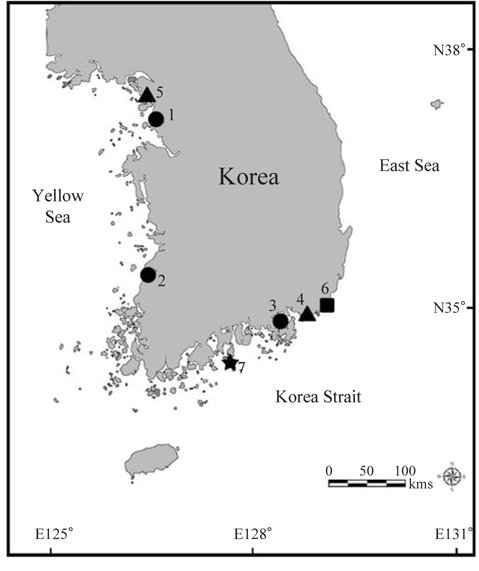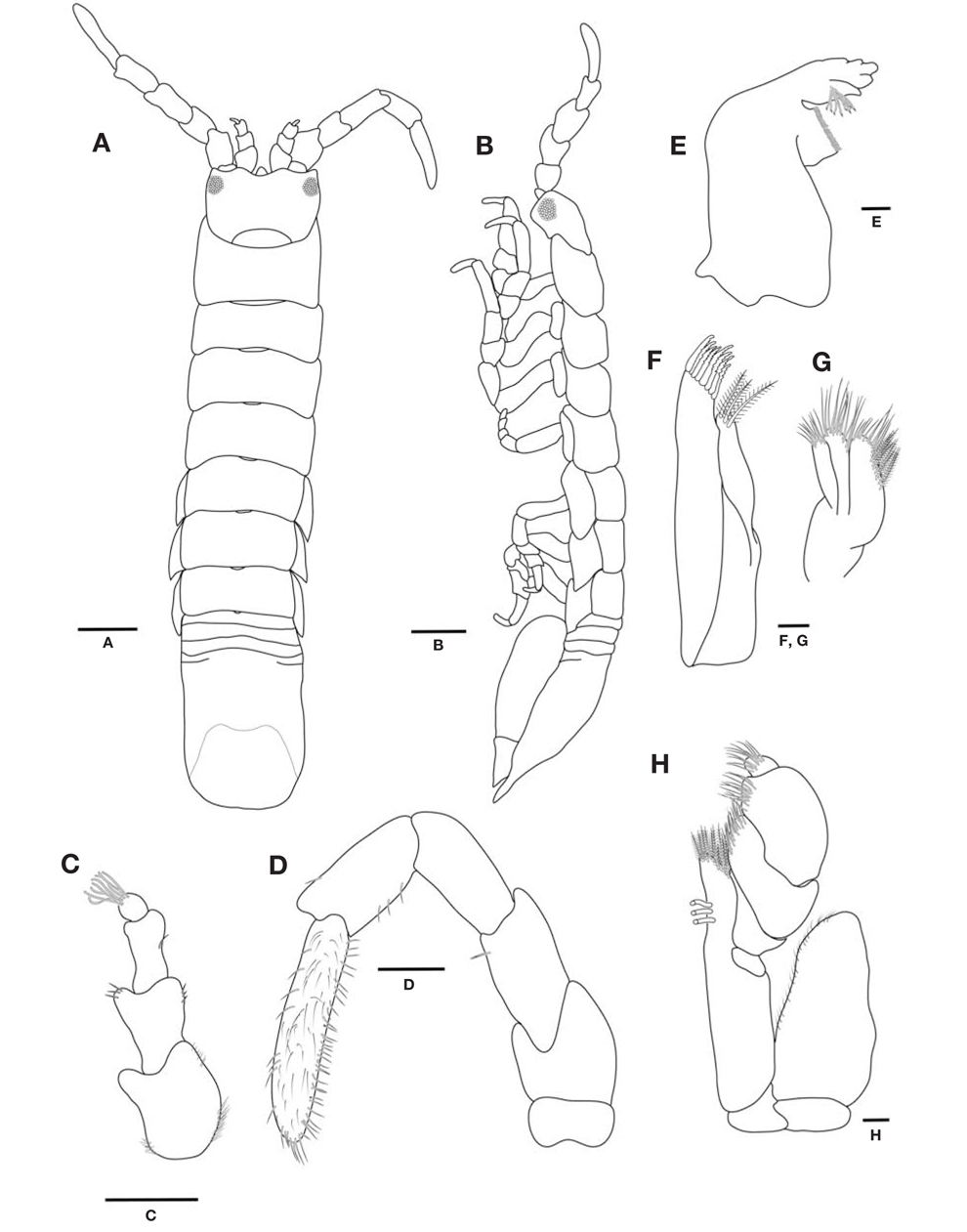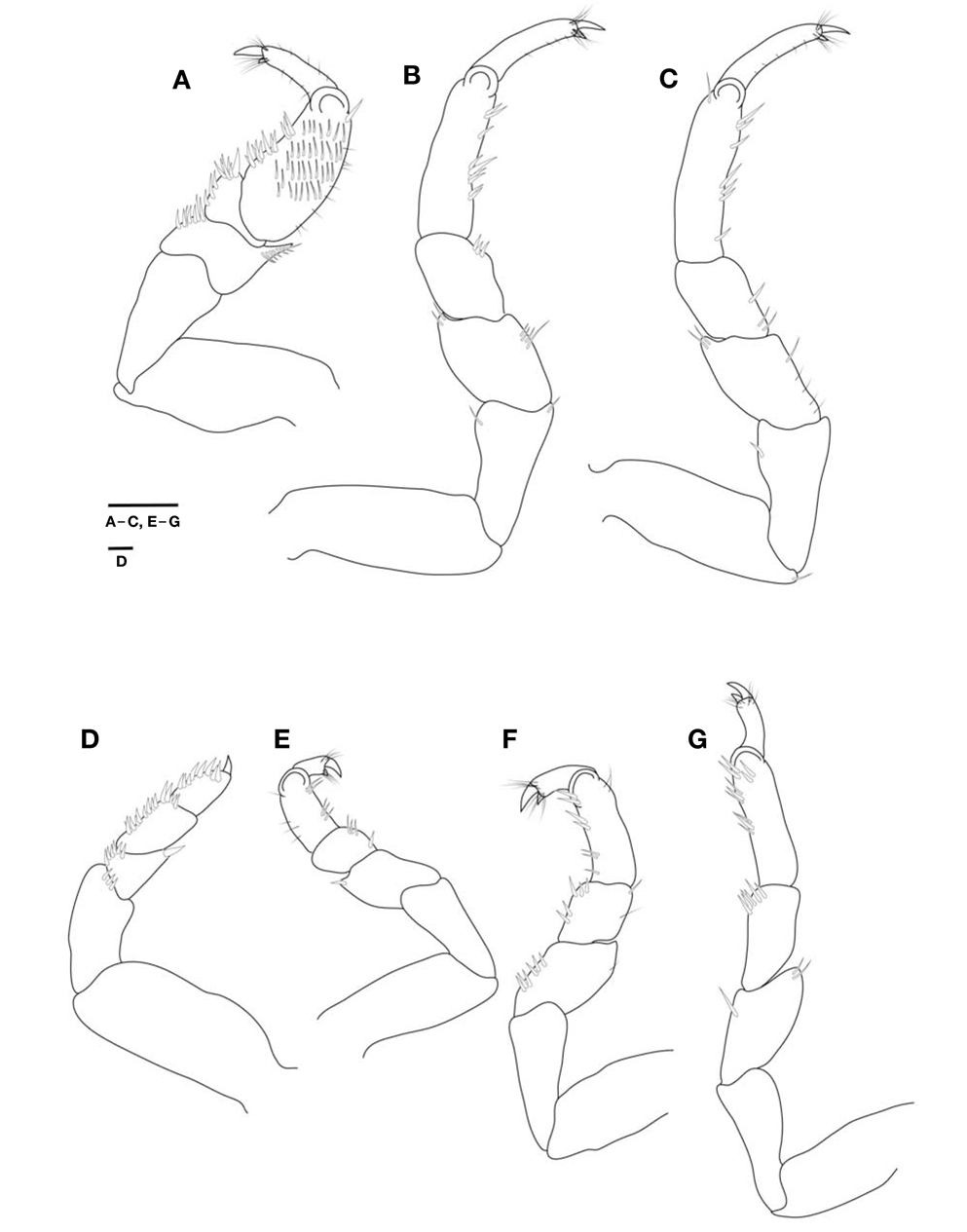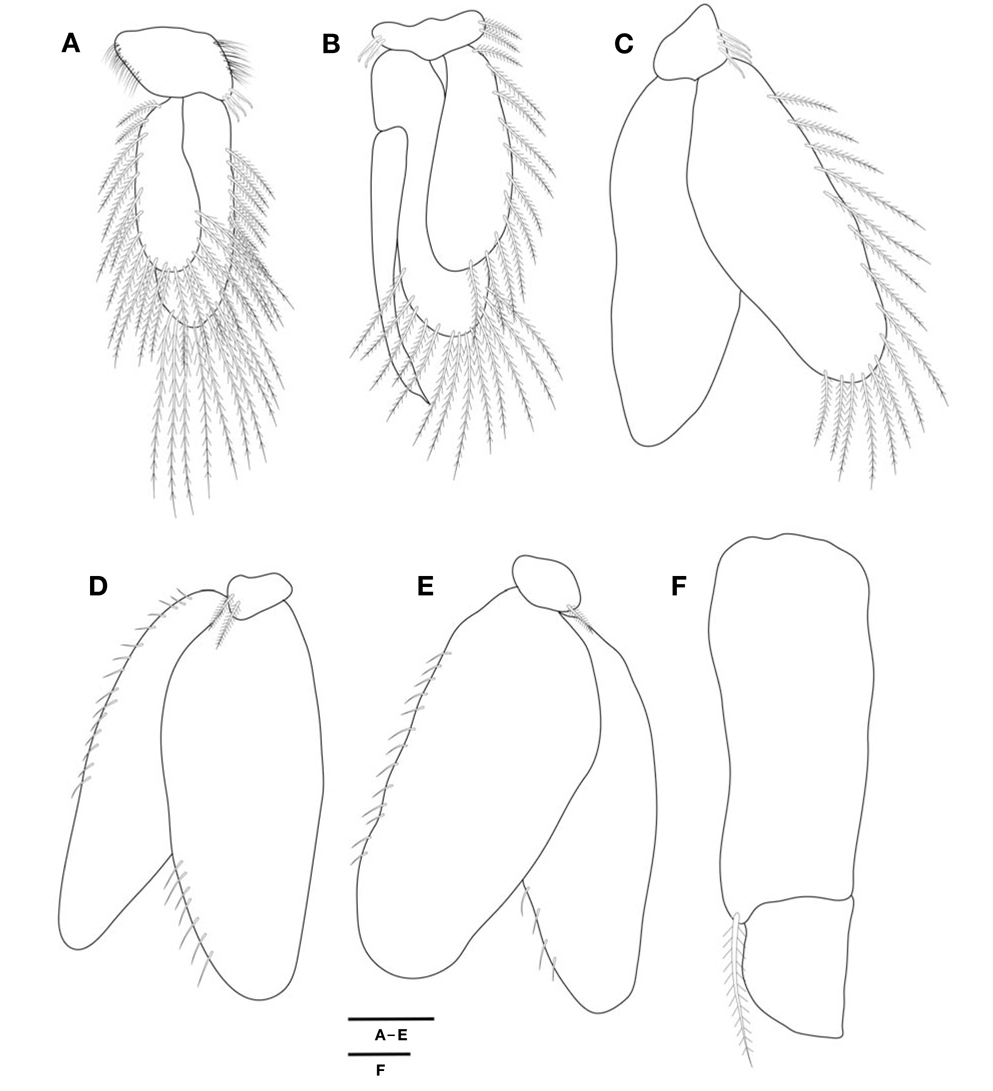



The genus
The genus
Here, we provide detailed descriptions and illustrations of the diagnostic characteristics of
>
Sample collection and morphological analysis
All of the specimens examined in the present study, were collected by light trap from the Geumodo Island (34° 30′N, 127° 45′E) in South Korea. They were preserved directly in 95% ethyl alcohol after collection. All of the examined specimens were deposited in the National Institute of Biological Resources (NIBR) and Inha University, South Korea.
The specimens were dissected and examined under a stereomicroscope (Model SZX-7; Olympus, Tokyo, Japan). Illus-trations of appendages were made with a drawing tube connected to a light microscope (Model DM 2500, X50-630; Leica, Wetzlar, Germany). Figure of the whole body was made using a drawing tube attached to a stereomicroscope (Olympus SZX-12). Measurements of the whole body length and appendages were done with a stage micrometer (Leica, Heidelberger, Germany) and an ocular micrometer.
The genomic DNA of the specimens was extracted from the appendages by using a DNeasy Blood and Tissue Kit (Qiagen, Valencia, CA, USA) according to the manufacturer’s instructions. The target DNA fragment of the
Order Isopoda Latreille, 1817Suborder Valvifera Sars, 18821*Family Holognathidae Thomson, 1904Genus Cleantioides Kensley and Kaufman, 1978
>
Material examined. Korea: 5♂♂, Jeollanam-do, Yeosu-si, Isl. Geumodo, 34° 30′N, 127° 45′E, 3 Jul 2013, by Light Trap, depth 3-4 m, collected by Hong SS.
Description. Male: Body elongate, cylindrical, about 10.7 mm, parallel-sided, almost 5.1 times longer than greatest width. Head approximately 1.6 times wider than long; anterior margin emarginated at midpoint; posterior margin convex. Eyes situated near antero-lateral angle of head. Coxal plates small and hardly visible dorsally on pereonites 2-4, but distinctly visible dorsally on pereonites 5-7. Pleonites composed of 4 segments (1-3 complete, 4 incomplete). Pleotelson parallel-sided with rounded apex; dorsum of distal half with slightly oblique plane with slightly bilobed depression (Fig. 2A, B).
Antenna 1 (Fig. 2C) short, composed of 4 articles; reaching to end of article 2 of antenna 2 peduncle; fourth article being the single flagellar article with 8 apical aesthetascs. Antenna 2 (Fig. 2D) composed of 6 articles; first article very short and almost immobile; second article very stout; articles 3-5 having almost similar lengths; sixth article being the single clavate article with many short fine setae and relatively long distal setae.
Mandible (Fig. 2E) lacking palp; incisor with 4-5 cusps; spine row of about 8 dentate spines; molar process stout. Maxilla 1 (Fig. 2F) endopod with 3 stout plumose setae apically; exopod with 8-9 serrate spines. Maxilla 2 (Fig. 2G) composed of 3 lobes; inner lobe with 8 plumose setae later-ally and 10 simple setae apically; inner portion of outer lobe with 13-15 simple setae, outer portion with 9-11 setae. Maxilliped (Fig. 2H) palp composed of 5 articles; four distal articles setose; endite with 3 coupling hooks and 10-11 plumose setae distally.
Pereopod 1 (Fig. 3A) stout; merus with 6-7 posterodistal and anterodistal spines; carpus with 9 spines on posterior margin; propodus expanded with 4 clusters of 11 spines on posterior margin with 33-35 serrulate setae on mesial surface; dactylus unguis stout. Pereopods 2 and 3 (Fig. 3B, C) similar, longer than first pereopod; ischium with 1-2 spines; merus with 6 spines, 3 spines and 4 simple setae, respectively; carpus with 3 spines on posterior margin; propodus with 9 spines on posterior margin, 1 spine on anterior margin and 8 spines on posterior margin, respectively; dactylus unguis slender. Pereopod 4 (Fig. 3D) greatly reduced and short; ischium with 3 posterodistal spines; merus with 6 spines on posterior margin and one stout spine on anterodistal margin; carpus with 14 spines on posterior margin; propodus with 8 spines on posterior margin; dactylus reduced to single compact unguis only. Pereopods 5-7 (Fig. 3E-G) increasing in length posteriorly; pereopod 5, merus with 1 spine on anterior margin; carpus with 4 spines on posterior margin; propodus with 5 spines on posterior margin and 4 setae on anterior margin; dactylus hook-shaped, with stout unguis; pereopod 6, merus with 6 spines on posterior margin and 1 setae on anterior margin; carpus with 5 spines on posterior margin and 1 spine, 1 seta on anterior margin; propodus with 7 spines on posterior margin and 2 setae on anterior margin; dactylus hook-shaped, with stout unguis; pereopod 7, merus with 1 spine on posterior margin and 2 spines on anterior margin; carpus with 6 spines on posterior margin; propodus with 8 spines on posterior margin and 2 spines on mesial surface; dactylus hook-shaped, with stout unguis.
Pleopod 1 (Fig. 4A), sympod with 3 retinacula and fine setae; exopod shorter than endopod, both with numerous plumose setae marginally. Pleopod 2 (Fig. 4B), sympod with 2 retinaculae and 2 plumose setae; both rami with plumose marginal setae; appendix masculine arising from the median margin of the endopod, tapering to acute apex surpassing to distal margin of endopod. Pleopod 3 (Fig. 4C), sympod having 4 retinaculae; both rami subequal in length; exopod with marginal plumose setae, endopod lacking plumose setae. Pleopod 4 (Fig. 4D), sympod small with 2 plumose setae; both rami subequal in length with some simple marginal setae. Pleopod 5 (Fig. 4E), sympod with 1 plumose seta; both rami similar to those of pleopod 4. Uropods (Fig. 4F) uniramous with single long plumose seta proximally; apically truncate.
Habitat. Habitat information from the type locality is not known. This species collected from the South Korea on sandy and gravel bottom with some green algae at 3-4m depth.
Key to the Korean species of the genus Cleantioides
1. The posterior plane of pleotelson has a median tubercle …………………………………C. japonica (Richardson, 1912) - The posterior plane of pleotelson unarmed (no tubercle) …………………………………………………………………………22. Posterior margin of pleotelson with emarginated apex ……………………………C. emarginata Kwon and Kim, 1992- Posterior margin of pleotelson with rounded apex ………33. Body almost 4 times longer than greatest width; coxal plates visible dorsally on pereonites 2-7 ……………………………………………………C. poorei Kwon and Kim, 1992- Body almost 5.1 times longer than greatest width; coxal plates visible dorsally on pereonites 5-7 ………………………………………………………C. planicauda (Benedict, 1899)
Remarks.
In general,



